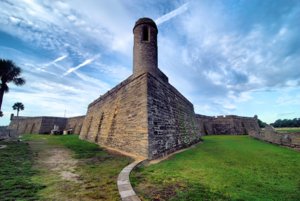Want to stroll the oldest street in the United States? Head for the oldest city in the United States!
That’s Florida’s St. Augustine, which was founded on September 8, 1565 by Spanish conquistador Don Pedro Menendez de Aviles.
Does that same sound familiar?
Regardless of how Aviles Street got its name, we know from its location that it was part of St. Augustine’s earliest layout. Today, Aviles Street is a narrow, bricked thoroughfare lined by historic buildings, residences, cafes and art galleries. It would have been a dirt street in a fledgling colonial outpost more than 450 years ago.
When the city was laid out, St. Augustine leaders followed traditional 16th-century Spanish civic design. That meant instituting a large municipal plaza or square, with important government, church and civic buildings surrounding the plaza, and narrow streets that radiated north-south and east-west off the plaza.
Where is Aviles Street?
If you’re familiar with St. Augustine, it’s the fourth street west of the city’s historic waterfront.
If you’re not familiar, find King Street and head east toward the waterfront. Aviles Street runs north-south, and you enter it off King Street, which runs east-west and forms the southern boundary of St. Augustine’s Plaza de la Constitucion.
Aviles Street will be on your right as you near the Bridge of Lions and Matanzas Bay. Its 16th-century parameters allows only pedestrians and horse-drawn carriages, therefore you can’t drive it.
Aviles Street ends at Bridge Street.
Is it really America’s oldest street?
Very likely.
In 2010, then-St. Augustine city archeologist Carl Halbirt noted that discoveries of 16th-century pottery shards underneath the current Aviles Street validated the thoroughfare’s age.
More recent digs in 2017 and 2018 uncovered human remains in the vicinity of King Street and Charlotte Street, the north-south street one block east of Aviles. Archeologists believe the burials, which were Christian in layout, may mark the site of an early Catholic church. Historical documentation sites the church in this vicinity from 1572 until 1702.
For perspective, consider Elfreth’s Alley, in Philadelphia, Pennsylvania. Marketed as the nation’s oldest residential street, the alley was established in 1706. The 32 homes that line it date from 1720 to 1838.
What does Aviles Street look like?
A handsome stone arch studded with historical plaques, marks its entrance.
Stroll south and you’ll find sidewalk cafes, restaurants, art galleries, the Spanish Military Hospital Museum, the St. Augustine Historical Society (headquartered in the General Kirby House), and the Father O’Reilly House Museum, among many other significant structures.
Art on Aviles
Aviles Street has long been a home for artists, their studios and galleries, and so it remains a vibrant part of that community.
It’s also a big player in St. Augustine’s First Friday Art Walk events.
On the first Friday of each month, art galleries across the Ancient City stay open from 5-9 p.m. Admission is free! Then, after-parties often follow at nearby establishments — a natural on Aviles thanks to its preponderance of galleries, cafes and restaurants.
Ready to live your northeast Florida lifestyle? Talk to ICI Homes here.








